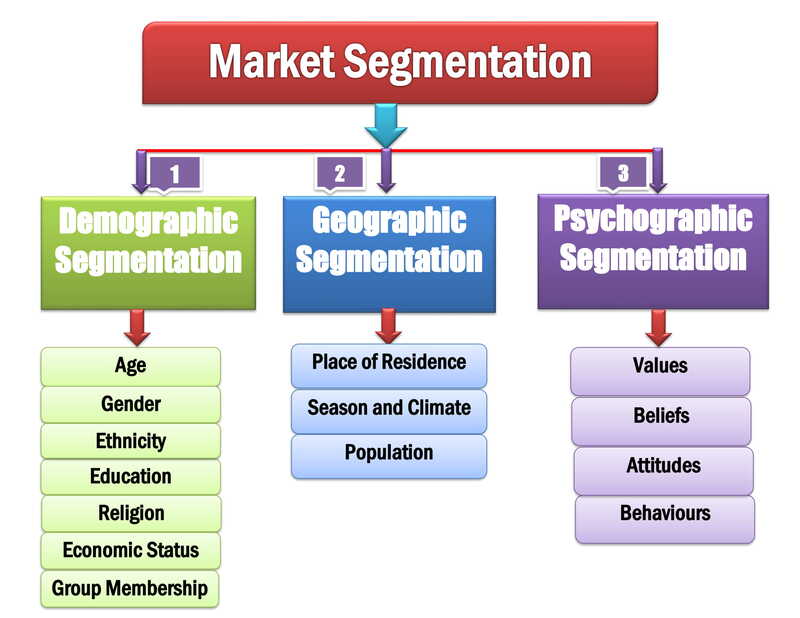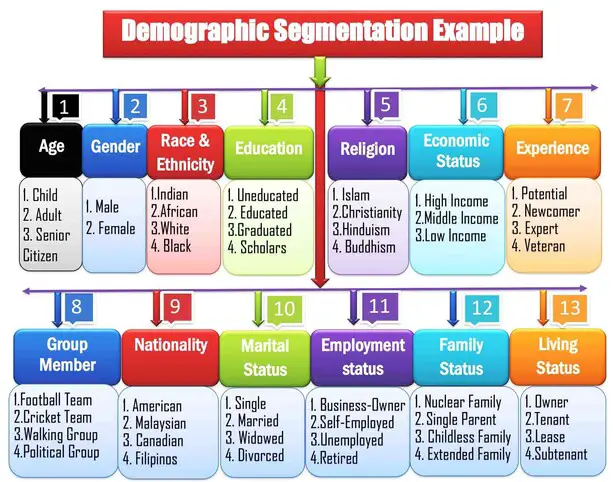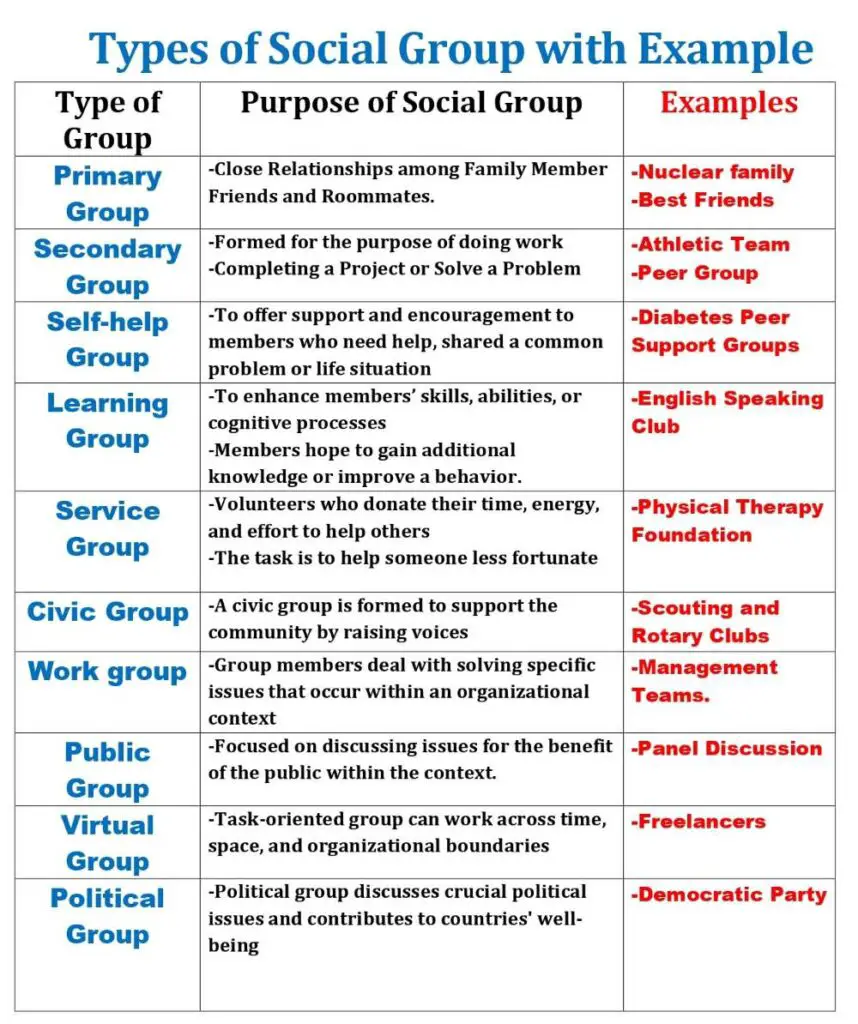Demographic Geographic Psychographic Market Segmentation. The 3 Basic types of market segmentation are Demographic Segmentation, Geographic Segmentation & Psychographics Segmentation. Also, Customer Profile Demographics Psychographics Geographics. Target Market Segmentation Theories- Maslow’s Hierarchy and VALS Segmentation Model in Consumer Behaviour.
Demographic Geographic Psychographic
Demographic Geographic Psychographic segmentation refers to the market segmentation technique based on the different factors related to the audiences. These are the most effective strategies to divide people into an identical subgroup. The purpose of demographic, geographic, and psychographic segmentation aims to separate people into subgroups to regulate a political campaign, commercial marketing, and advertising.
Market Segmentation
Market segmentation separates people into similar subgroups based on geographic, demographic, and psychographic factors. It is an essential process for social, political, and commercial campaigns and advertising. It is an excellent way of sending messages to a targeted group of people rather than everyone. A long time ago, audience segmentation was primarily applied for social and political campaigns. Nowadays, it has become trendy in market segmentation. Therefore, audience segmentation is known as market segmentation.
Market Segmentation Examples
For example, a political leader is conducting a campaign asking to vote for his political party. So, the leader targets the voters only to conduct the campaign. In many countries all over the world, the minimum age for being a voter is eighteen years. For example, in the USA, citizens can vote in any public election who are a minimum of 18 years old or older than 18 years. So, the political leader persuades citizens of the constituency an age minimum of 18 years. Here, a citizen of the constituency refers to the habitant of a particular area which is also an example of a geographic factor of market segmentation. Similarly, age is an example of demographic characteristics of market segmentation.
Demographic Geographic Psychographic

Types of Market Segmentation
The 3 Types of Market segmentation are
- Demographic Segmentation
- Geographic Segmentation
- Psychographic Segmentation
Demographic Segmentation
Demographic segmentation refers to the process of separating people into similar subgroups based on demographic factors such as age, gender, ethnicity, education, religion, economic status, and group membership.
For example, a political organization is dividing people based on age. They are looking for voters whose age is more than 18 years. It is an example of demographic segmentation. Demographic questionnaires are crucial to conducting survey and market research.
Demographic Factors
The demographic factors are a set of audiences’ characteristics, such as age, gender, ethnicity, education, religion, etc.
The demographic segmentation factors are Age, Gender, Ethnicity, Education, Religion, Economic status, Experience, Group Member, Nationality, Marital Status, Employment Status, Family Status, and Living Status.
Examples of Demographics in Marketing

Geographic Segmentation
Geographic segmentation means separating people into similar subgroups based on geographical factors such as residence, climate, and population. It highlights the location and environment of the audience.
Geographic Factors
The Geographic Factors are Place of residence, Season and Climate, and Population.
Place of Residence
Place of residence refers to rural and urban areas where the audience lives permanently or temporarily. People from urban and rural areas are different in their lifestyles, such as dress up, outlook, and attitudes. Therefore, market segmentation is essential before starting an advertising or social campaign.
Season and Climate
Season refers to a specific time of year categorized by a particular climate condition. For example, the United States has four seasons, including Autumn, Spring, Summer, and Winter.
For example, Ice cream companies earn more money in the summer season than in winter. In contrast, the blanket-selling company focuses on the winter season for marketing. The company needs to focus on geographic segmentation for the advertising campaigns.
Population
Population means the inhabitants of a particular area; for example, the capital city, metropolitan city, or small town. However, they imply almost similar characteristics but have some differences too.
Psychographic Segmentation
Psychographic segmentation separates people into similar subgroups based on psychographic factors such as values, beliefs, attitudes, and behaviors. These factors indicate the internal mental characteristics of people.
Psychographic Factors
The four psychographic factors of market segmentation are values, beliefs, attitudes, and behaviors—these four factors help understand how the audiences feel and behave.
For example, a political leader’s values, beliefs, attitudes, and behaviors are definitely distinguished from a physician’s.
Example of Psychographic segmentation
For example, You may feel that giving blood is important (Attitude) because an adequate blood supply is necessary to save a life (Belief) and because you respect human life (Value). Your (Behavior), as you participate in the blood drive and donate blood, is a logical and observable extension of your
Values
Firstly, values mean a judgment of what is right or wrong, desirable or undesirable. For example, most people share equality, freedom, honesty, fairness, justice, good health, and family. Another example, we respect human life naturally (Value).
Beliefs
Secondly, a belief is something you accept as true, and it is stated as a declarative sentence. For instance, students believe that the use of the internet improves the quality of students’ research. Furthermore, You may feel that giving blood is important because an adequate blood supply is necessary to save a life (Belief).
Attitudes
Thirdly, an attitude is a statement expressing an individual’s approval or disapproval, like or dislike. Usually, attitudes evolve from our values and beliefs. Many values and beliefs interact to complicate our decision-making. For example, You may feel that giving blood is very important (Attitude).
Behaviors
Finally, Behavior is an individual’s observable action. It is the way of how we act or behave toward others. It is the combination of other psychological factors such as values, beliefs, and attitudes.
For example, You may feel that giving blood is important (Attitude) because an adequate blood supply is necessary to save a life (Belief) and because you respect human life (Value). Your behavior is a logical and observable extension of your outlook as you participate in the blood drive and donate blood.
Advantages and Disadvantages of Psychographic Segmentation
Advantages of Psychographic Segmentation
- Deeper Understanding of Customers: Psychographic segmentation provides a more comprehensive understanding of customers beyond basic demographic information like age and income. It helps marketers understand what drives consumer behavior, preferences, and purchasing decisions.
- Targeted Marketing Communications: By segmenting the market based on psychographic variables, marketers can tailor their messaging and communication strategies to resonate with specific consumer segments. This personalized approach increases the relevance of marketing efforts, leading to higher engagement and response rates.
- Enhanced Product Development: Psychographic segmentation enables companies to develop products and services that align with the needs, preferences, and lifestyles of different consumer segments. By catering to the unique desires and aspirations of target customers, companies can create offerings that stand out in the market and generate greater customer satisfaction.
- Improved Customer Retention: Understanding the psychographic profiles of customers allows companies to build stronger relationships and loyalty. By delivering personalized experiences and addressing the values and interests of customers, companies can foster deeper connections and increase customer retention rates.
- Effective Market Positioning: Psychographic segmentation helps companies identify niche markets or segments with distinct needs and preferences. By positioning their products or services to address the specific desires of these segments, companies can differentiate themselves from competitors and gain a competitive advantage in the market.
- Increased Marketing ROI: Targeting specific psychographic segments allows companies to allocate their marketing resources more efficiently. By focusing efforts on segments most likely to respond positively to their offerings, companies can optimize their marketing ROI and achieve better results with less expenditure.
- Adaptation to Changing Trends: Psychographic segmentation enables companies to stay attuned to evolving consumer trends, lifestyles, and preferences. By continuously monitoring and analyzing psychographic data, companies can
Disadvantages of Psychographic Segmentation
- Subjectivity and Interpretation Bias: Psychographic segmentation relies on subjective interpretations of consumer attitudes, values, and behaviors, which can introduce bias into the segmentation process. Different analysts may interpret the same data differently, leading to inconsistent segmentation outcomes.
- Limited Generalizability: Psychographic segments may not generalize well across different markets or demographics. Consumer preferences and behaviors can vary widely based on cultural, regional, or temporal factors, making it challenging to apply psychographic insights universally.
- Complexity in Data Collection: Gathering psychographic data can be more complex and time-consuming compared to demographic or geographic data. It often requires extensive market research, surveys, and analysis to uncover consumers’ attitudes, values, and lifestyles accurately.
- Overlap Between Segments: Psychographic segments often overlap, making it difficult to create distinct and actionable segments for targeted marketing efforts. Consumers may exhibit characteristics of multiple psychographic segments simultaneously, blurring the boundaries between segments.
- Privacy Concerns: Collecting and analyzing personal information related to consumers’ attitudes, values, and lifestyles raises privacy concerns. Consumers may be wary of sharing sensitive information, especially in light of data privacy regulations and concerns about data security breaches.
Two Market Segmentation Theories
-
Maslow’s Hierarchy of Psychological Needs theory
-
VALS Segmentation Model in Consumer Behaviour
Maslow’s Hierarchy of Needs Theory
Maslow (1943) initially stated that individuals must satisfy lower-level deficit needs before meeting higher-level growth needs. It is a well-known content theory of motivation. However, he later clarified that satisfaction of a need is not an “all-or-none” phenomenon, admitting that his earlier statements may have given, for example, “the false impression that a need must be satisfied 100 percent before the next need emerges”. According to Maslow’s theory, human needs can be divided into five categories. These are physical, safety, belongings, love, esteem, and self-actualization needs.
1. Physical needs: Physical needs are basic human requirements for livelihood, for example, water, food, rest, warmth, and so on.
2. Safety needs Requirements for security and protection purposes, such as personal security, health security, employment, property, etc.
3. Belongings and love needs: Relationship with people around us for giving and receiving affection, for example, intimacy, friendship, family, and friends.
4. Esteem needs: Refers to self-confidence, self-esteem, and self-respect of humans; for example, everyone has a certain talent, so we need to pat on the back from time to time for exploring their intellectuality.
5. Self-actualization needs: Refers to self-fulfillment desiring to become the most that one can be; for example, we need our goals to feel that we have fulfilled our destiny or reached our potential.
VALS Segmentation Model in Consumer Behaviour
The VALS (Values, Attitudes, and Lifestyles) segmentation model is a widely used framework in consumer behavior research and marketing. Developed by social scientists Arnold Mitchell and S. Robert Horton, the VALS framework categorizes consumers into distinct psychographic segments based on their primary motivations, attitudes, and behavioral patterns. Here’s an overview of the VALS segmentation model:
- Values: The VALS model identifies two primary dimensions of human values: resources and self-orientation. Resources refer to the extent to which individuals prioritize achieving goals related to self-enhancement or self-transcendence. Self-orientation relates to individuals’ motivations for seeking stimulation and variety versus stability and order in their lives.
- Attitudes: VALS classifies individuals based on their attitudes toward innovation and change, as well as their level of openness to new experiences and ideas. This dimension reflects individuals’ willingness to adopt new products, technologies, or lifestyles.
- Lifestyles: The VALS model distinguishes between primary and secondary motivations that drive consumer behavior. Primary motivations reflect individuals’ core values and priorities, while secondary motivations are situational or contextual factors that influence behavior in specific circumstances.
Based on these dimensions, the VALS segmentation model identifies eight distinct consumer segments:
- Innovators: These consumers are characterized by their high levels of resources, self-confidence, and openness to new ideas and experiences. They are often early adopters of innovative products and technologies.
- Thinkers: Thinkers value knowledge, education, and intellectual pursuits. They tend to be rational and deliberate in their decision-making process, preferring products and brands that align with their values and beliefs.
- Achievers: Achievers are motivated by success, status, and achievement. They strive for material wealth and social recognition, preferring established brands and products that symbolize success and prestige.
- Experiencers: Experiencers seek excitement, adventure, and variety in their lives. They are spontaneous, impulsive, and open to new experiences, often seeking out novel and unconventional products and activities.
- Believers: Believers are traditional, conservative, and value-oriented consumers. They prioritize security, stability, and family values, preferring established brands and products with a track record of reliability.
- Strivers: Strivers are ambitious, aspiring individuals who seek to improve their social and economic status. They are motivated by success and recognition, often emulating the lifestyles and behaviors of higher-status groups.
- Makers: Makers are practical, hands-on individuals who value self-sufficiency, craftsmanship, and utility. They prefer functional, no-frills products that offer value and durability.
- Survivors: Survivors are cautious, risk-averse consumers who prioritize security, safety, and basic needs. They are typically on fixed incomes or facing financial constraints, preferring low-cost, practical solutions to their needs.
Conclusion
Target market segmentation has become a viral strategy for social, political, and business purposes. Now, people live in a global village as global citizens for the easy accessibility of social media. Therefore, politicians and business persons pay more attention to market segmentation for political campaigns and marketing publicity on social media such as Facebook, Instagram, Twitter, YouTube, etc.
